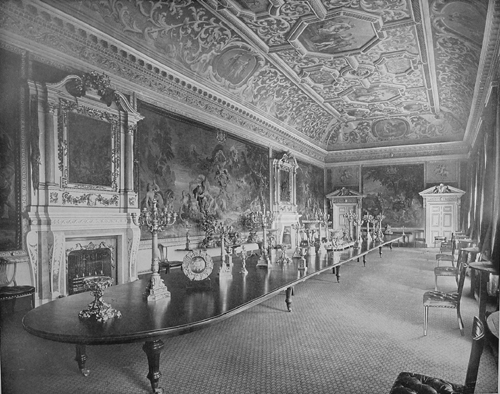
Brief history of the State Dining Room and its decoration1
This room is 75 feet by 25 feet (23m x 8m) and is located to the west of the Temple Room. It was the State Gallery until 1817 when it assumed its current name. The ceiling has an elaborate plaster entablature supporting a deep cove, this has painted decoration dated 1747 by Francesco Sleter, including Hebe feeding Jupiter’s Eagle (east), Cupid playing with two Graces (north), Cupid asleep with two Graces (south) and Diana and her Hounds (west), the spaces between these paintings are decorated with animals including swans and their cygnets, pigeons and rabbits. There are three large octagonal paintings on the central flat of the ceiling. These are probably early 19th century replacements for the original by Robert Jones. They are Venus disarming Cupid (east), Venus on her Chariot, crowned by Cupid and attended by the Three Graces (centre) and Venus at her Toilet, attended by the Graces (west). There are also eight smaller octagonal panels depicting pairs of vases and classical reliefs. The areas between these paintings are decorated with painted acanthus and all the paintings are bordered by white and gilt plaster beams decorated in guilloche.
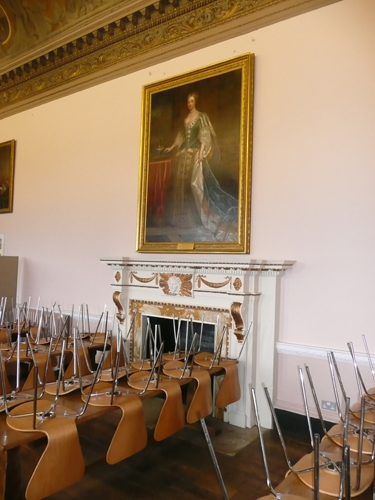
The two chimneypieces on the north wall date from the 1920s. The original pair were sold in 1922, and were of white and yellow Siena marble, with elaborately carved wooded overmantels that contained paintings now in America, these are Goddess conducting Learning to Truth (east) and Mercury conducting Tragedy and Comedy to Parnassus (west). There are four paintings above the two doors in the west and east walls of male and female centaurs with Bacchic emblems and lyres, probably painted by Robert Jones. The walls used to be hung with five Brussels tapestries commissioned by Viscount Cobham; they depict the triumph of classical deities: Ceres, Bacchus, Neptune, Mars and Diana. They were sold in 1922 for 8,000 guineas and are now in Switzerland. The walls are now hung with various portraits of people associated with the house that have been acquired over the years. The room is now used by the School as a dining room.
Above the end doors are four rectangular paintings showing male and female centaurs with Bacchic emblems and lyres. The insignia of the Garter seems to have been added to the broken pediments above each door after its award to Earl Temple in 1760.
There are accounts for the lowering of the windows in the State Gallery of 1771. This may suggest that the painted and gilded window architraves date from this time.
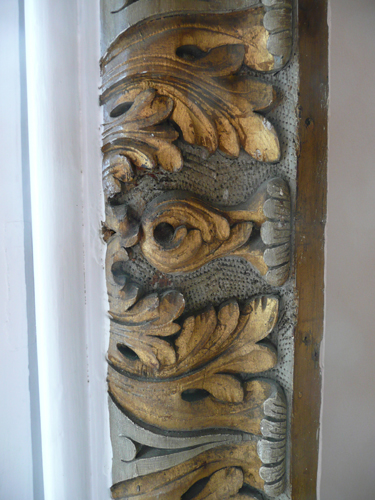
Paint Analysis
Many elements have been decorated on four or five occasions, although original paintwork survives on the window architraves and some early gilding can be seen on the ceiling.
Some elements of the cornice have been decorated twice, while others have received up to five schemes of paint. The non-gilded sections of the cornice were originally painted in a greyed-white. The first treatment of the frieze has been reversed. Originally the (roughcast) bed of the frieze appears to have been gilded while the foliate scroll detail in the bed of the frieze appears to have been painted. This is interesting as it suggests that originally the rough surface of the frieze bed would have caught the light of the candles and glinted. The only other building where I have found a similar use of gilding was in the Library at Newhailes.
The lower wall was originally painted off-white, as was the joinery, which was heavily gilded. A set of tapestries hung on the upper wall.
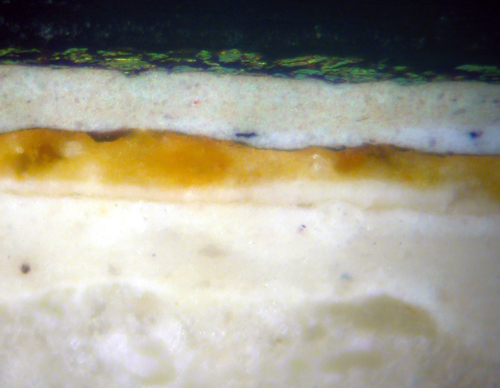
This shows a post 1960s bronze paint applied over original gilding.
Notes
1 Source – Michael Bevington. Stowe House. Paul Holberton Publishing. 2002 & Wikipedia.
2 Benton Seeley’s guidebook: ‘Stowe: A Description of the Magnificent House and Gardens of The Right Honourable Richard Grenville Temple, Earl Temple… Embellished with a General Plan of the Gardens, and also a separate Plan of each Building, with Perspective Views of the same.’1797 edition. It went through seventeen editions between 1744 and 1797.
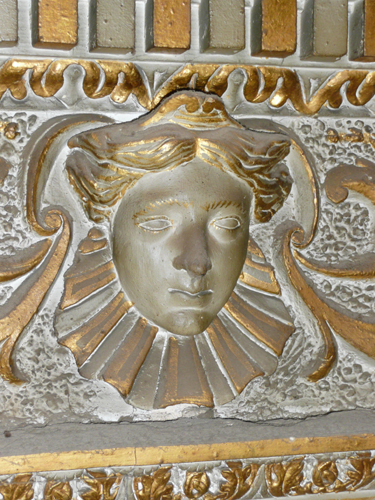
Originally the rough-cast bed of the frieze was gilded and the raised plasterwork was plain painted
The Stowe House Preservation Trust was founded in 1997 in order “to restore and preserve Stowe House for the benefit of the nation and the public.” The school remains as a tenant and the house is opened to the public on more than 200 days per year.
View Larger Map











No comments yet. Be the first!